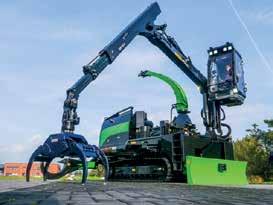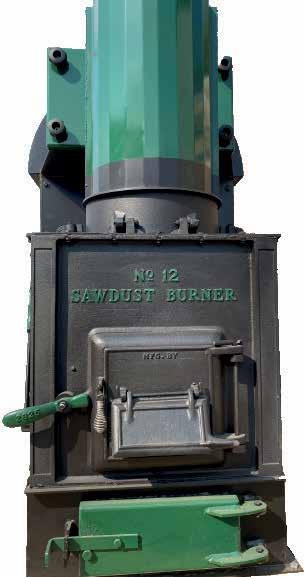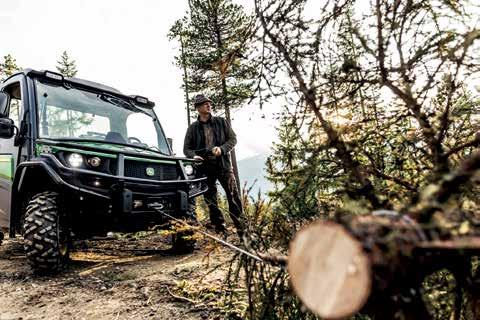
10 minute read
Ensuring safe storage of wood pellets
Clare Bone, Partner and health and safety law expert at Brodies LLP, comments on the dangers of transporting and storing wood pellets
The popularity of wood pellets as a form of heating has continued to rise over the last few years, as many of us turn away from fossil fuels and look for more sustainable and renewable ways to heat our business or home. The UK remains one of the world’s largest consumers of imported as well as domestically produced product.
The ongoing war in Ukraine has sparked a shortage of wood pellets here in the UK and abroad, Russia having been a major exporter of wood pellets to the West. As UK manufacturers of wood pellets look to increase production it is worth reminding the industry of the significant health and safety risks that exist in the storage and transportation of this product.
The composition of wood pellets is such that in normal, everyday conditions they will produce carbon monoxide, generating higher levels in the first few weeks af ter production. An odourless, tasteless gas, carbon monoxide will deplete the air of oxygen, posing the risk of serious injury or death to anyone exposed to it.
If wood pellets are stored for any length of time, this can lead to a build up to dangerous levels, increasing the risk of harm. There have been a num ber of fatalities both at home and abroad where individuals have accessed areas where wood pellets are stored and have succumbed to the carbon monoxide fumes produced.
As carbon mon oxide will be present wherever you are storing or transporting wood pellets it is important to ensure appropriate controls are in place. Such controls include adequate ventilation and restriction of ac cess to unauthorised persons.
Any storage area should be assessed to determine if it should be classed as a confined space. Under the Confined Space Reg ulations 1997, a ‘confined space’ in this context has two defining features.
Firstly, it is a place which is enclosed and, secondly, there will be a reasonably foreseeable risk of serious injury from hazardous substances or conditions within the space or nearby.
There should be suitable ventilation in place. Warning signs should be displayed to warn of the confined space, risk of carbon monoxide poisoning and preventing unauthorised access. For employees required to access such areas there should be suitable and sufficient training, with safe working procedures in place, based on a site-specific risk assessment, to ensure a safe place and system of work.
For more information, the HSE’s Approved Code of Practice ‘Safe Work in Confined Spaces’ (L101) provides useful guidance for employers and employees.
Manufacturers, suppliers and distributors of wood pellets should also ensure on health effects of exposure to the product it relates to as well as hazard evaluation related to its handling, storage, or use.
As such it should include information on the potential for the build-up of carbon monoxide in enclosed areas, its effects, and other such relevant information to alert the end user to the risks arising from storage of the product and to inform them on what measures they ought to take to minimise the risks of exposure to carbon monoxide.
By taking these steps, those involved in the manufacture and supply of wood pellets will be doing what they can to comply with their own health and safety duties to their employees and those who use their products and will minimise the risk of someone succumbing to ill health or death through exposure to carbon monoxide.
As the demands for a greener, more sustainable energy supply continue to increase, taking such steps ensure that wood pellets are not only an appealing alternative to fossil fuels, but a safe form of en-
Confor Members Free Legal Consultation
Confor Members have access to a free legal helpline, administered by Brodies LLP. Get in touch for guidance on key issues that impact forest owners and the forestry sector.
Whether your query is employment law, health & safety, planning, tax or property-related, one of our experts will be happy to give you a free initial consultation. More info: https://bit. ly/3yPGRI1
For members based anywhere in the UK
Brodies LLP 0131 228 3777 www.brodies.com confor@brodies.com
For members based in England/Wales
Atkinson Ritson Solicitors
01228 525221 www.atkinsonritson.co.uk info@atkinsonritson.co.uk popularity for tasks including leading out plants on restock sites, vegetation control on footpaths, and getting people out to remote areas of an estate or land holding. They require what is often referred to as an “active rider” to maintain the vehicle’s stability and grip.




However, in recent years there has been a surge in popularity for sit-in style ATVs. These are often referred to by the name of the John Deere sit-in ATV, the Gator, in much the same way as we call any make of vacuum cleaner a Hoover!

What is behind this shift to sit-in ATVs? There are number of benefits, so it is difficult to identify any one reason. However, motives include increased load carrying capacity; increased towing capacity; wider and longer wheelbase aiding stability; die- one person; and for some it is having a cab with a heater!


Dare I say it, but they are also easier to drive, especially for less confident or inexperienced riders.
Sounds great, but what about the downsides? Sit-in machines are heavier than the sit-astride ATVs, so if you do get stuck it may well be a more onerous task to extract the machine; transporting them from site to site will require a larger trailer and you’ll probably not be able to utilise the trailer behind the ATV; and price is a factor with many costing a similar figure to a car, and probably twice that of a sit-astride ATV. They are serious investments!
All models featured in this article are four-wheel drive machines. Most manufacturers offer a crew cab style machine too, where moving people about is as important as cargo or towing.
On the subject of safety, anyone who looks at the HSE fatalities statistics annually will be aware that, sadly, ATVs – specifically sit-astride ATVs - feature prominently in these figures. For many employers, providing a similar vehicle but one which features a ROPS structure and seatbelts is a proactive decision to improve their em-
There are many companies offering attachments for ATVs and many have now increased their product offering to ensure that there are attachments for sit-in machines now too. As always though, please ensure compatibility with your machine and any attachments.

In terms of the all-important operator certification, both NPTC City and Guilds and Lantra offer operator certificates of competence. Both recognise the difference between a sit-astride and a sit-in ATV, but Lantra also differentiate between sit-in machines that are conventionally steered, and skid steered. All the models covered in this review are conventionally steered machines.
Honda
Probably the manufacturer that most of us would look to if we were after a sit-astride ATV, or certainly well up the list. Honda was a relative latecomer to the sit-in ATV market. Why, I’m not sure – perhaps they didn’t see the need, or perhaps they were worried it would dilute their sales of sit-astride machines, but they have joined the party at long last with the Pioneer 520.
Whilst the machine does take the form but it is smaller than most and certainly narrower.
Power comes from a 518cc petrol engine, on-brand for a maker like Honda. Transmission is a five-speed variant (unlike many others who offer a CVT transmission), which can be operated manually or automatically.
The Pioneer 520 comes with selectable 2/4wd, a 204kg bed capacity and a 454kg towing capacity. Options include fabric doors; a solid roof; windscreen and rear of cab panel; guarding etc.

Kawasaki
Kawasaki by comparison were fairly early converts to the sit-in ATV market and their model range name - the Mule - is another often used as a generic reference to sit-in
ATVs. The current offering comprises four models, two petrol and two diesels.

The entry level SX 4x4 features a 400cc petrol engine and is a two-seater model. Equipped with drum brakes all round, selectable 2/4wd and rear diff lock. Load capacity of 181kg and towing capacity of 500kg.
The Pro-MX is a 700cc petrol machine, and like its smaller sibling features a CVT transmission. Improvements to this model include disc brakes all round and a 36-litre fuel capacity.
There are two machines in the diesel range, the Pro-DX and the Pro-DXT. Both share a 1-litre diesel engine, but the big difference is that the DXT is capable of carrying up to six passengers including the driver. Great for going on safari!
As a result of this increased passenger capacity, the load space is reduced considerably.

Across the range, accessories include a “hard” cabin (i.e. solid doors); mounting kits for winches; load space accessories and uprated suspension components.
Kubota
Kubota are well known for their ground care machines, their excavators, and in recent years have added numerous models to their agricultural tractor range. They also offer two models of sit-in ATV.
The RTV-X1110 and RTV-X1140, both diesel machines equipped with 3-cylinder engines providing around 24 horsepower. The main difference in these models is that the X1140 is a crew cab style machine, equipped for four passengers (including the driver) and features a longer wheelbase to accommodate this.
Unlike some of the other manufacturers mentioned here, the Kubota RTV range features a rear mounted hydrostatic transmission which is claimed to be less susceptible to slippage than a belt driven CVT machine. Load capacities of 500kg in the load bed and up to 590 towing capacity. The load bed is hydraulically tipped as standard.
Numerous options including a fully enclosed cab; tyre options and colour –Kubota orange or Realtree Camo can be chosen for the RTV-X1110 and 1140.
continued on p56
Polaris

The Polaris Ranger range of machines has attracted quite a following in recent years. With numerous models available including two-seaters, three-seaters and crew cab versions, and petrol and diesel variants, there is something for everyone here. Interestingly, Polaris also offer an electric version, the XP Kinetic.
Here are some of the highlights from the range of three-seat machines, likely to be the most popular version.
The Ranger 1000EPS, a 1,000cc petrol machine featuring a high/low/reverse CVT transmission. The load space is rated for 454kg and the tow hitch for 1134kg. The Ranger Diesel features a 900cc Kubota diesel engine and shares a similar transmission to the petrol variant. Load and towing capacities are similar to the petrol version too. Options include wheel and tyre choices; various cabin versions; winches etc.

The XP Kinetic features a 14.9kWh battery which can provide a range of up to 70km depending on loading and driving conditions. The XP kinetic is fitted with a similar transmission to its conventional siblings and features the same style of drive choice – all-wheel drive, two-wheel drive, or two-wheel drive turf mode (rear differ- ential not locked).
Given the moves to reducing fuel usage, this surely has to be considered nowadays in certain applications.
John Deere

The John Deere Gator range originally started as a golf course maintenance machine, featuring a wide and low structure and turf tyres. This range of machines is still available, but the Gator range has moved into the utility/industrial sector with a range of four machines: three diesels and one petrol version.
As with many other manufacturers, a crew cab style is available with capacity for four people.
The petrol version is powered by an
800cc and is capable of 454kg in the cargo area and a towing capacity of up to 907kg. It complies with Road Homologation (as do all Gators) so getting it road registered would be fairly simple.
The diesel versions, the X865M and X865R, are essentially the same vehicle, featuring an 854cc diesel engine with similar carrying and towing capacities as the petrol version. The main difference is the X865R is more refined inside the cab, with features such as cloth seats and air conditioning.
As with other manufacturers, a range of options exist for the Gator, including bull bars; light guards; winches etc. The option of an open or enclosed cab also exists on most models.
With woodland to secure a future for some of the UK’s most important broadleaved tree species. tial part of a multi-faceted approach to climate change.
Through the partnership, oak, sycamore, silver birch, hornbeam, beech and blackthorn will be planted in research trials and seed orchards on the National Trust’s 21-hectare site near Uffington, South Oxfordshire. Tree breeding programmes will allow healthy individuals with better form and growth rates to be selected across the country and assessed over many years in research trials.

The superior trees are used to establish seed orchards which produce improved seed, also known as Qualified and Tested Forest Reproductive Material (FRM). Trees grown from improved seed which have faster growth and an increased rate of sequestering carbon.
The tree breeding research programmes will give The National Trust direct access to broadleaved trees fit for the future to use across their estates and as part of their ambitions to establish 20 million trees by 2030. This will ensure the trees planted will likely be adapted to a changing climate and remain healthier for longer.
John Deakin, Head of Trees and Woodlands at National Trust said: “The National Trust cares for tens of thousands of hectares of trees. This exciting partnership will not only help to directly contribute to the achievement of [our 2023] target but will also allow us to contribute more widely by supporting the Future Trees Trust to make available the highest quality trees to the wider tree and woodland sector.”
The arrangement also necessitates the relocation of the Future Trees Trust Head Office to the Buscot and Coleshill Estate, committing both organisations to a longterm partnership which will supply seed of many broadleaved species for woodland resilience in the future.
Speaking about the opportunity, Future Trees Trust CEO John McLaughlin commented: “This is an exciting opportunity for Future Trees Trust, for the first time in our history we will be taking direct control of land, which will really help deliver our 10year strategy.
“Working with such a renowned organisation as the National Trust will increase awareness of our work to ensure improved trees will be the natural choice for anyone planting trees. We also look forward to helping the National Trust to deliver on their ambitious tree planting targets and welcome the opportunity to co-locate our headquarters with the team at the Buscot and Coleshill Estate.”







